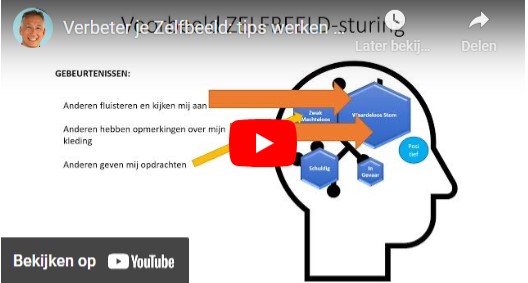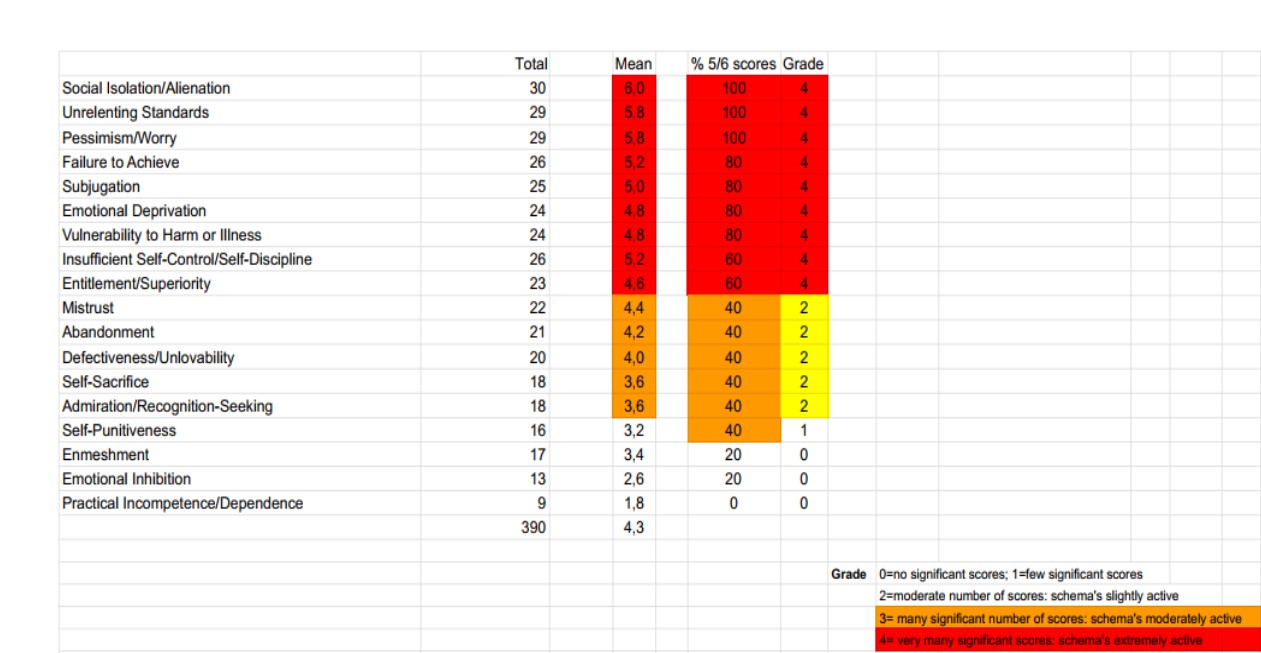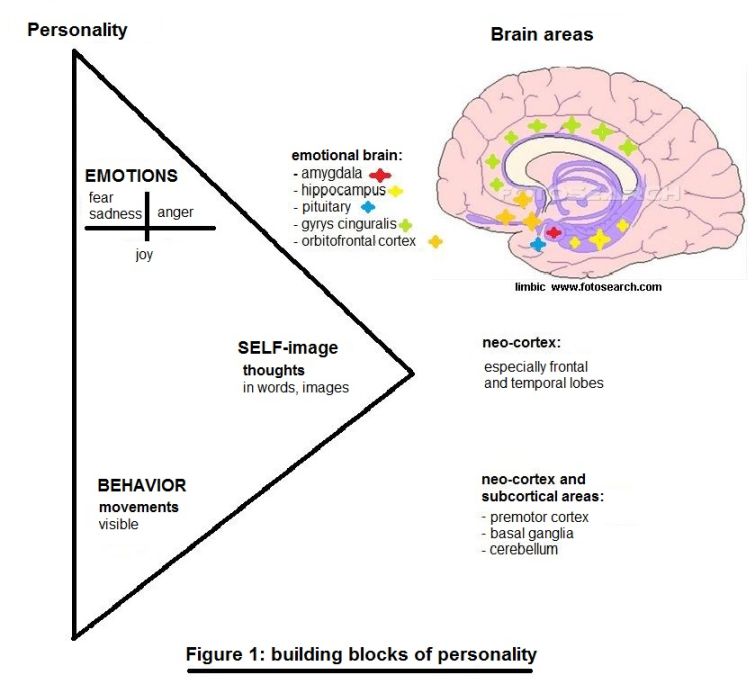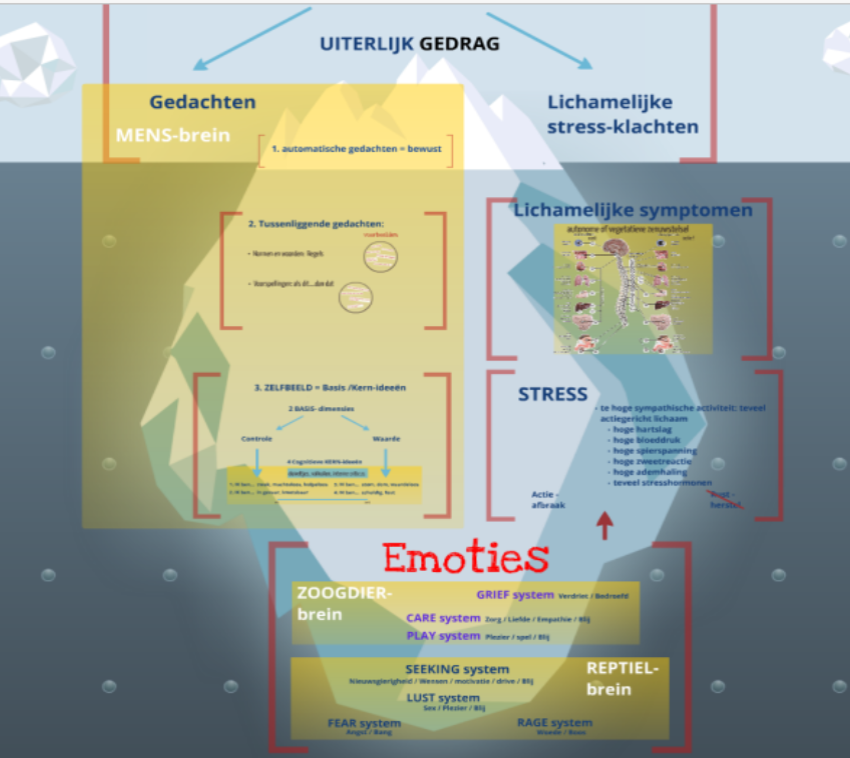- Home
- Personality
- Self-image model
Self-image: what exactly is it ?
Ga HIER naar de Nederlandse versie van deze pagina
On this page you will find a detailed explanation of the Self-image. It goes into much more detail about the Self-image because there are quite a few misunderstandings about it. That is a pity, because in the cognitive Self-image model it forms the core of your personality. See also the page about the Personality Model.
To get started, you can watch the video about the Self-Image Model below on Youtube. For the die-hards among us: it takes about 12 minutes! However, this clip is in Dutch. The English version will be released later this year.
The Self-image
The Self-image is an extensive cluster of ideas in your subconscious brain stored in your long-term memory. Normally you are not aware that it exists. In the Self-image model that I have drawn up, based on models and theories from trauma and personality psychology, I use 4 fundamental (negative) ideas about your Self as the basis of your Self-Image.
However, your Self-image does not only consist of these Self-image devils, but of course also of all kinds of other ideas about your Self, your Ego (old-fashioned name). e.g. I'm from Hengelo (Ov.), I'm 1.84m, I'm a man, I'm a psychologist, I'm funny, smart, play padel quite well, like bowling. So there are hundreds of ideas that we (usually unconsciously = we often don't consciously think about it) have about ourselves.
It also follows that we have a certain degree of self-confidence and self-control. For example, if you are fairly certain that you can play tennis well (e.g. because you have often won in competitions) due to past experiences, then you have a lot of self-confidence and self-control in that area of tennis.
But of course there are many more areas in life where you have experiences and where you have therefore also developed ideas about yourself and your skills. Ideas about yourself, how you come across to other people, how you can interact with other people, how you are in social interactions, are also part of your Self-image.
The Self is in fact a cognitive structure made up of all these ideas above. That Self is actually built up in the brain and stored in your Long-Term Memory. Antonio Damasio also calls it the Autobiographical Self (For more information about his ideas about the neurological basis of that Self, you can read several of his books on the subject. See also the book tips on this page).
Self-image demons
In the Self-image model, as a psychologist I don't focus so much on your total Self-image because it contains thousands of ideas about your Self. That wouldn't work in therapy. Inspired by trauma psychology and in particular by the special trauma treatment EMDR (Eye Movement Desensitization and Reprocessing), I have simply assumed that there are only 4 basic ideas in our Self-image that are negatively oriented: the so-called Self-image devils ( see the Youtube video about the Self-Image Model).
They are always (every second, even if you are reading this!) present in our subconscious to affect your Self-image, to make it smaller. Simply because this core of our Self-image has been formed in our Long-Term-Memory since birth. Mammals also have the same Self-image, but this is often not expressed in language as it is in humans. Technically, these Self-image devils were called "negative core beliefs" or "negative basic cognitions" within the cognitive models. But I have found that such words often do not resonate well within the therapeutic setting.
Below you'll see a graphic representation of the Self-image core with the 4 Self-image demons:
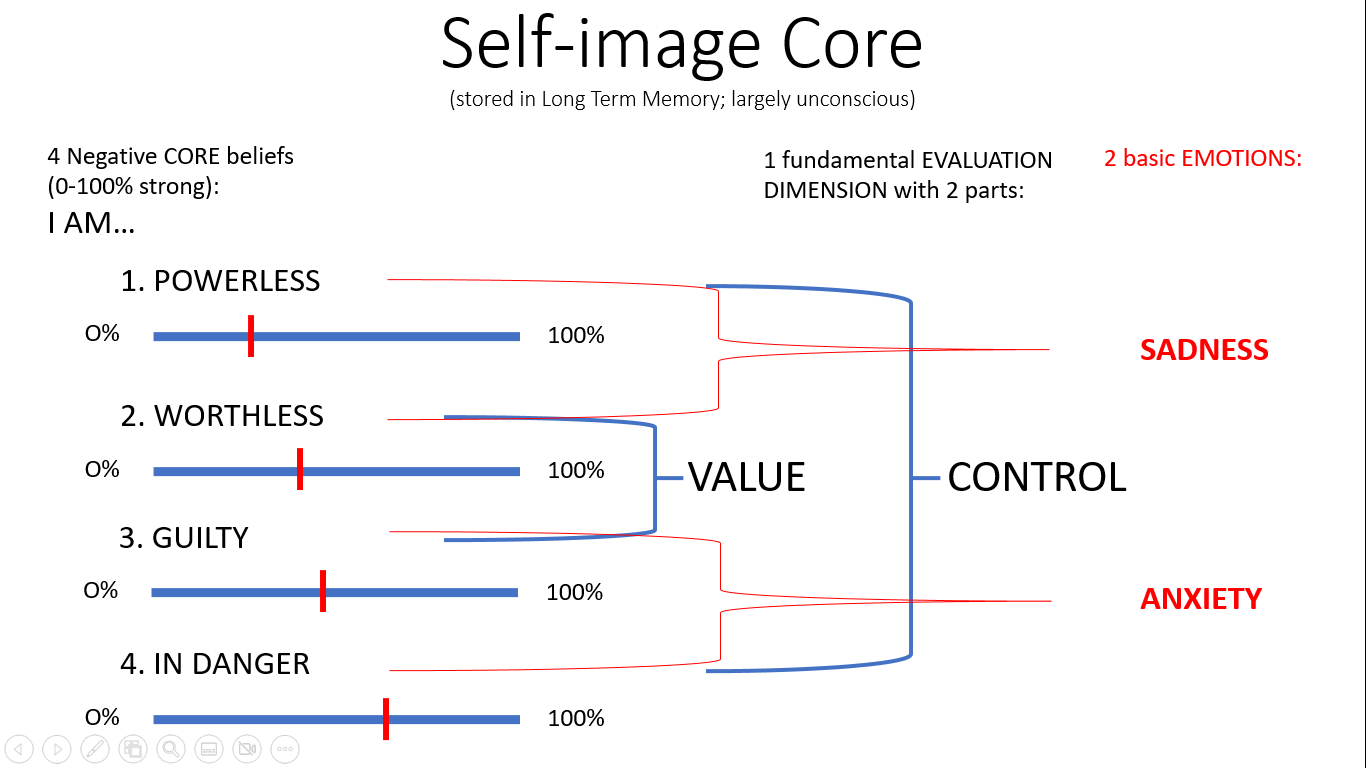
Self-image: experiences, traumas and emotional problems
What many people and psychologists underestimate is that your Self-image is constantly under attack by the 4 Self-image devils. These Self-image devils are working in your subconscious every second to attack, to reduce your Self-image. If you are not aware of this, these attacks can successfully affect your Self-image.
A Self-image devil is in fact an image, a phrasing used by me to make it clear that your Self-image is always dynamic, it constantly changes in strength. For the sake of simplicity, I assume that each Self-Image Devil is stored in your (unconscious) Long-Term Memory with a certain strength, expressed from 1 to 100%. This strength is changed by your experiences every day.
Let me make it clear with an example. If you have stored in your Self-image that your Self-image devil 'I am worthless' is about 60% strong (e.g. if you had an upbringing where 1 or both of your educators constantly humiliated you with comments such as "well, well, but a Got a 7 in English? That should have just been a 9, you moron!", "Look at your sister: she's perfect!", then you're super sensitive to any comment or event that suggests you're worthless indeed. Your self-image demon Worthless will therefore immediately score a point for every comment from a colleague who expresses negative criticism of you.The power of this Self-image demon increases after 1 such negative comment from 60% to 60.3%.
It is hard to say how strongly this little devil will go up (0.3%, 0.6% or even 5%) because it strongly depends on how strong the criticism is, how strong your emotions are with this comment, how many thinking errors you make, etc.). In this example, it is about the realization that there are several events in one day in which this Self-image devil I am Worthless can score a point and thus become stronger.
It is essential to realize that if you are not aware of such an attack on your Self-image, the Self-image devil remains and even grows further, so becomes stronger. Such an attack can actually be seen as a psychotrauma. The greater the impact of such a trauma, the stronger a self-image devil has become.
That simply explains that with low self-esteem, someone's emotional problems only get worse if they don't consciously learn to defend themselves. Old patterns of thinking and acting are not easily changed. In fact, patterns are memory traces that have often been reinforced for years. According to modern memory theories, such memory traces will not disappear, but they may become less powerful. This is only possible if other (more positive) memory sports are formed.
These positive memory traces must then be made by bombarding the Self-Image Devil, in fact the old strong negative memory trace, with new more positive memory traces. In other words: against the Self-image devil you have to create and store several positive information traces yourself.
Because the 4 Self-image devils are directly linked to the 2 basic emotions Fear and Sadness, you can imagine that if these devils are very strong in strength (= low self-esteem), then there is a large reservoir of Fear and Sadness in your brain (and body). The likelihood of emotional problems is then very high.
The self-image model can well explain why depression cannot just disappear. For example, if a person's working conditions improve or if a lottery happens to be won, mood may improve and depression may decrease. Indeed, a retreating depression often causes a somewhat higher self-esteem (e.g. because someone then sees more that he/she is worth it, that he/she is stronger than previously thought and that the depression can be overcome), but I think that this is not enough. If therapy is not sufficiently focused on strengthening someone's Self-image, then the chance that someone will end up in a depression again, will be quite high. Especially when setbacks come again in someone's life.
The role of setbacks in life
It is essential for the growth of your Self-image that you learn HOW to deal with setbacks. A setback ensures that a Self-image devil always gets the chance to score a point, so to become stronger. It is precisely because of a setback that the Self-image devils come into action. It is up to you to 1. recognize them and 2. attack them immediately so that they become weaker instead of stronger and are also stored in your Long-Term-Memory.
Only in your consciousness can you change the content of your Long-Term Memory. The Self-image devils must therefore come to the surface, precisely through setbacks. Without setbacks they do NOT rise and remain untouched as strong as they already were.
It works the same way the other way around: precisely by becoming aware of compliments from others, of good things you do for yourself every day, you can make your Self-image devils smaller. If you do not consciously compliment yourself every day, then you do not consciously attack the Self-image devil in your unconscious Long-term memory. Hopefully an example will make this clear.
Suppose you are kind to your partner by making some tea for him/her. Your partner then says "thank you, honey." Then you have to consciously think about it and realize that you are indeed a Valuable and Loving person. Because the Self-image devil that goes with this (I'm Worthless) is subconsciously in your long-term memory to keep quiet after such a compliment. But if you consciously realize that this compliment from your partner is a clear proof against this Self-image devil (I am Worthless), then you have attacked and weakened this devil in your consciousness. After all, the proof is the attack against this devil, namely: "see, you are worth it as a person, my partner just said it himself".
As childish and above all simple as this sounds, the mechanism of strengthening your Self-image does work that way in your brain. We now know this from memory theories (information is only really changed in your unconscious long-term memory if you process it in your consciousness/working memory) and from the personality theories of Jeffrey Young and Aaron Beck, among others.
In summary: setbacks in life are necessary to learn to strengthen your Self-image. However, if setbacks become psychotraumas because you already have a lower self-image and therefore you do not see the setbacks as resources but as negative non-learning moments, then the Self-image devils will actually become stronger. This may also explain that people with a strong Self-image (and consequently healthy thinking patterns) generally after a psychotrauma such as e.g. a traffic accident or an assault or dismissal, do not get Post-traumatic stress disorder (PTSD). The majority of people do not develop PTSD (estimates range from 70 to 80%).
Resilience
Resilience is a word in psychology that is used to indicate that someone can handle setbacks, cope with them. I think that has everything to do with a strong Self-image. This includes, for example, strong self-confidence, knowing very well what you can and cannot do, high self-control in which you are trained to handle intense emotions (= strong emotion regulation).
However, it is not only your Self-image that plays a role in Resilience. Your emotional system (stress system) is also important and that is largely genetically determined. For example, your emotional brain/system may be weak, which means that your emotions can quickly become intense (partly under the influence of your hormonal system).
People born with a strong temperament have such a strong emotional system. But also people who are highly sensitive, so quickly overstimulated by sounds, smells, images, have a more intense emotional system. That does not mean that such people automatically get emotional problems! But it does mean that they need to be taught more clearly how to manage their more intense emotions that can rise quickly. Their upbringing will therefore be tighter, more structured and more challenging for their parents.
That is also the reason why children with ADHD, Autism Spectrum Disorder (ASD), high sensitivity, generally develop more emotional problems than 'easier' children. Because often the educators do not know how they can best teach these children to control their emotions and to strengthen their Self-image. All this has to do with insufficient knowledge and ignorance.
Of course I don't own the truth. But from science, especially from neuroscience, models about the human brain and emotional system have emerged that have been increasingly confirmed by studies over the years.
In my YouTube video about Personality and Self-image and the relationship between them, I use these newfangled models. In my opinion, they can explain people's emotional problems better than many old-fashioned (eg Freudian or Jungian) models that were never based on scientific studies but on speculation in a time when science was not nearly as advanced as it is now. I advise everyone to watch my Youtube videos about Self-image and Personality again and try to understand how it all works. The videos will be released in English later this year.
Positive psychology and the Self-image model
The newfangled models that I rely on have 1 very powerful advantage: you can indeed change and get a stronger Self-image! What is needed for this is a workable and understandable model about your emotional system, your self-image and your personality.
Secondly, you must realize that most of your Self-image is learned and dynamic. Your Self-image is therefore NOT carved in natural stone, so it can be changed. What probably cannot be changed is your temperament (your emotional system). You can, however, learn to better understand your emotional system and thus better control your emotions. After all, you do that with your cognitions, your thinking patterns (ways of thought).
That is why I think that cognitive behavioural therapy with the above correct models is a very powerful therapeutic method to make people structurally stronger. I will talk about a special trauma treatment, namely EMDR, elsewhere on this site. Because EMDR has also given new fantastic insights into how people can bounce back quickly, how strong their self-healing ability is. I think that really has to do with a strong Self-image.
Have A Great Story About This Topic?
Do you have a great story, remarks or any additions to or about this? One that could help other people as well and above all is constructive? Then please share it!
DISCLAIMER
I will not take any responsibility for how the information on this website will affect you. It always remains your responsibility to handle all information with care and in case of medical or mental problems you should ALWAYS consult a professional in your neighbourhood!
Ik neem geen enkele verantwoordelijkheid voor hoe de informatie op deze site u zal beïnvloeden. Het blijft altijd uw verantwoordelijkheid om al deze informatie zorgvuldig te bekijken. In het geval van lichamelijke en/of mentale problemen dient u ALTIJD een professional in uw directe omgeving te waarschuwen!
